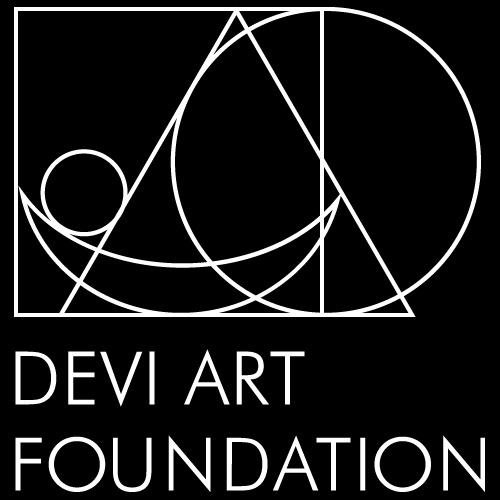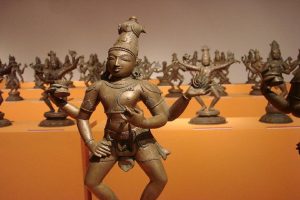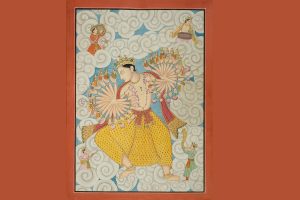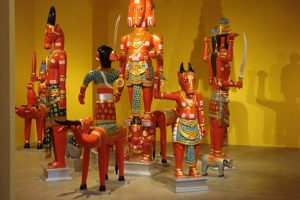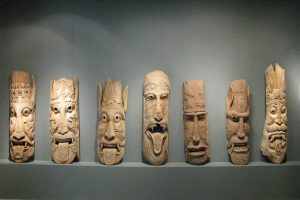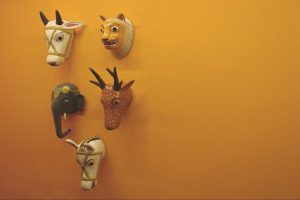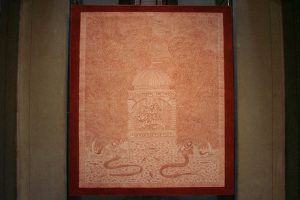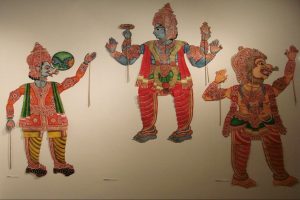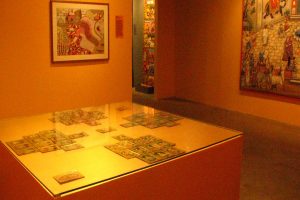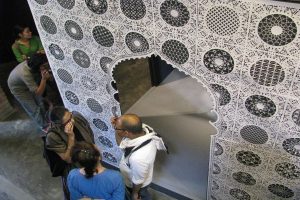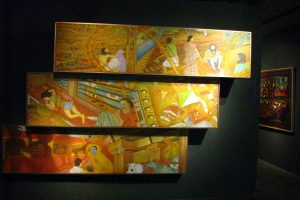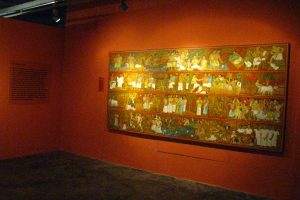Vernacular, in the Contemporary I & II (2010-11)
Story of the Making
Building upon an existing collection, Devi Art Foundation initiated a conversation of seeing “Vernacular Art” which was rooted in tradition, through a contemporary lens. Vernacular in the Contemporary was a 2-and-a-half-year long research project, aimed at bringing these overlooked artists to the fore. Jackfruit Research and Design, an arts consultancy in Bangalore, led by Annapurna Garimella, curated this exhibition in two parts with works from the Collection, as well as freshly commissioned works. As the title suggests, it attempted to engage with ‘Vernacular’ Artists’ works in a contemporary context. Nearly 300 artists were asked about their ideas for a ‘dream project’, out of which 75 artists were commissioned to bring their ideas to realisation. As a curator, Annapurna put the emphasis on the process instead of the end-result, which was also documented and put into the catalogues that came afterwards.
Highlights
– The idea of work and working is what connects the diverse group of artists presented in Vernacular, in the Contemporary. The project culminated with the two exhibitions:
Vernacular, in the Contemporary Part One: Working (2010-11)Vernacular, in the Contemporary Part Two: Working Consciously and Working Reflectively (2011)
– Devi Art Foundation funded the establishment of a yearlong residency in Bangalore for the selected 90 artists & their collective responses guided the conceptualization of the exhibition and the creation of a dialogue.
– The artists who had dream projects were mostly present in the second part of Vernacular, in the Contemporary. Those who did not have one or wanted the research and curation team to develop a project for them were for the most part in first half of the exhibition. The placement of artists also had much to do with how they work and how they think about work.
– Artists showcased in Part One – Working, have three different approaches to creating art, each of which allows them to consolidate or reinvigorate the boundaries of their art practice. Those in the first section titled “Keeping the Flame”, in the exhibition catalogue, are concerned with how they, through their work, can keep artistic inheritances alive. Artists in the second section of the catalogue – “Nature” are concerned with the natural world and are aware of how important the materials, themes and cosmologies they derive from it are for their work. For these artists, the natural world is an archive which turns into Nature through the Culture of their art. Given the artists’ dependency on the environment for their livelihood and their inspiration, the rapid environmental changes in India have a large impact on their perception of and relationship with the natural world and its various flora and fauna. Artists in the third section, “Making a Change” are interested in altering the way they work or practice their art. They make large efforts to shift formal strategies, such as scale and compositional organization, as well as technique and medium.
– The first section of Part Two – Working Consciously – shows the work of artists who look outward, develop a perspective on the larger world through their work and purposefully make art to represent ideas and issues that lie beyond their respective art forms. Artists in this section are not only concerned with “working” but also are interested in engaging worlds external to their art. They are conscious of how the archive (“Mining the Archive”), contemporary events and politics (“Current Affairs”) and urbanization (“Over the City”) enter their practice, both in terms of process and theme.
Vernacular, in the Contemporary Part One: Working
Duration: November 2010 – February 2011
Participating Artists:
Anwar Chitrakar, Banku Chitrakar, Baua Devi and family, Bibhu Maharana, D. Nageshwar (Nakash), Dhavat Singh Uikey, Dileep Shyam, Dinesh Chandra Mohanlal Kumar and M. Rengaswamy, Ghanshyam Nimbark, Jangarh Singh Shyam, Japani Shyam, K. Siva Prasad Reddy, Kalyan Joshi, Kailash Chand Sharma, Kapil Sharma, L. Rathakrishnan, Mayank Kumar Shyam, Nankusia Shyam, Neelkant Choudhary, Prabhudas Mistry, Pushpa Rao, Radha Sollur, Ramesh Tekam, Rathnakara Gudikar, S. Anjaneyulu, Santosh Kumar Das, Sanjaybhai Manubhai Chittara, Tarshito and Puspa Rao, Tribal Women Artists Cooperative Hazaribagh, Usman Tirandaz, Vijay Siddaramappa Hagargundgi
Vernacular, in the Contemporary Part Two: Working Consciously and Working Reflectively
Duration: March 2011 – June 2011
Participating Artists:
Ajithan Puthumana, Amit Mahadev Dombre, Amrita Das, Basanth Peringode, Baua Devi, Bhajju Shyam, Bhuri Bai, Dileep Shyam, Durgabai Shyam, Ganga Devi Bhatt, Ghanshyam Sharma, Hashim Akhtar Naqvi, Jivya Soma Mashe, Kalam Patua, Kamlesh Kumar Roy, Kirti Khatri, Laltu Chitrakar, Monimala Chitrakar, Mayank Kumar Shyam, Nankusia Shyam, Pratik Prabhakar, Ramesh Tekam, Rani Chitrakar, Reena Umbersada, Sanuar Chitrakar, Shanti Bai, Sonsay Kashyap, Subash Vyam, Sudha Venkatesh, Sukhnandi Vyam, Swarna Chitrakar, Teju Jogi, The Jogi Family and Yakub Chitrakar
